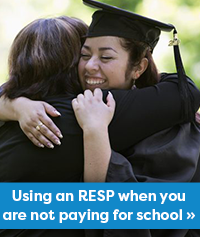Saving with a Registered Education Savings Plan

Oftentimes when expectant or new parents meet with our Financial Advisors, they ask: “When and how much should I start saving for my child’s education?” Our team encourages saving as much as you can as soon as you can. Youth with money set aside for their post-secondary education are 50% more likely to continue their education after high school graduation than students with no savings.
When looking for ways to save for your child’s education, the method our team suggests is the Registered Education Savings Plan (RESP), which you can open for your child as soon as you receive their social insurance number. Here are some of the common questions asked around RESPs:
When looking for ways to save for your child’s education, the method our team suggests is the Registered Education Savings Plan (RESP), which you can open for your child as soon as you receive their social insurance number. Here are some of the common questions asked around RESPs:
- Why should I choose an RESP for my child? While you could use other methods to save for your child’s future, the RESP is widely considered the best option. In addition to any returns you earn from your investments, there are Government contributions you can take advantage of. The Canada Education Savings Grant (CESG) will match your contributions, up to 20% on the first $2,500 you deposit annually. For example, if you can contribute $2,500 a year in your child’s account, the Government contribution will be $500 a year. Calculate your contribution amount to receive the lifetime maximum of $7,200 from this grant. There are also other grant programs you may qualify for, including the Canada Learning Bond (CLB) for low income families.
- Which plan should I choose? One of the things you’ll want to consider is whether you will open a family or individual plan. The family plan is meant for children related to you either by blood or adoption and gives you more flexibility to share the funds between your children, as it’s needed. An individual (or non-family) plan can be designated to a beneficiary that you aren’t related to by blood. This would be the option anyone else would choose if they wanted to open an RESP for your children. While anyone can contribute to an RESP for your child, only one account will be eligible to receive Government grants.
- Do I have to make a monthly contribution to an RESP? No, you can make contributions whenever works for you. Consider setting up a regular Automatic Funds Transfer (AFT), which is a money transfer controlled by you. When you set it up, you decide how much to transfer, when it’s transferred each month and where the money is deposited. By setting up an AFT, your contribution happens automatically each month, and you don’t need to think about it beyond budgeting for it. There are many options for the AFT such as weekly, bi-weekly, monthly or whenever is most convenient for you. When planning your contributions, there are two things to keep in mind:
- The maximum lifetime amount that can be deposited into an RESP is $50,000. If you contribute more than this, there will be penalties.
- Your child’s money can be invested, so the more you are able to deposit, the more earning potential you have.
- Are there limits on where my child can go to school? In order to take advantage of all the funds in an RESP, the money must be used for post-secondary education, including universities, colleges and trade schools and programs. For example, an RESP can’t be used to pay for private grade school. Your child is free to study wherever they wish, including outside of Canada with their RESP, as long as the school is a designated education institute. Find out if the school your child is interested in is a designated educational institute.
Revised Jul. 7, 2022







